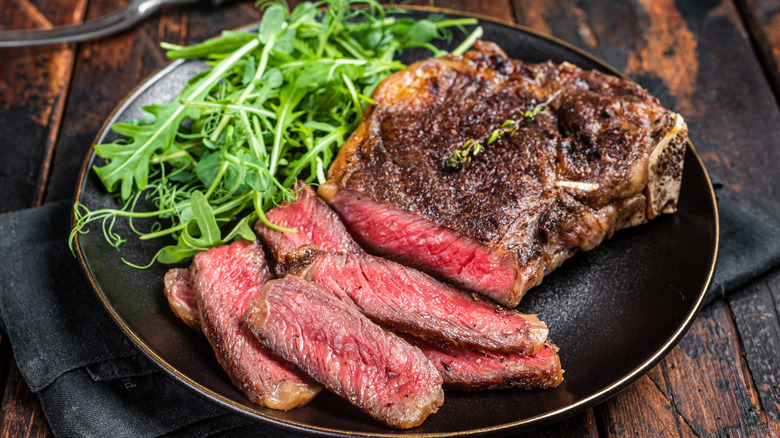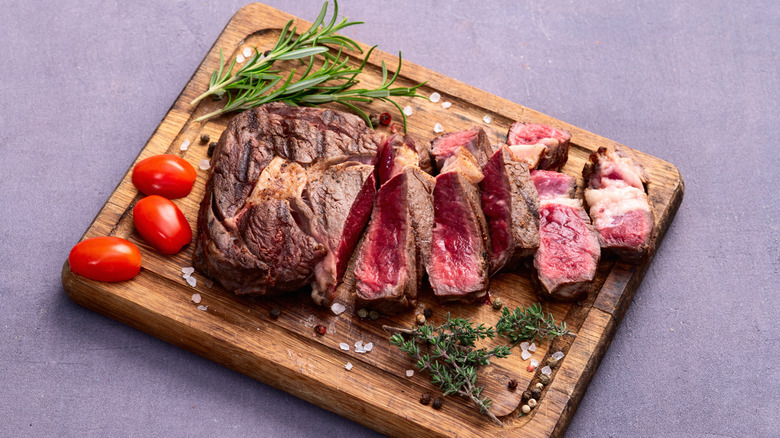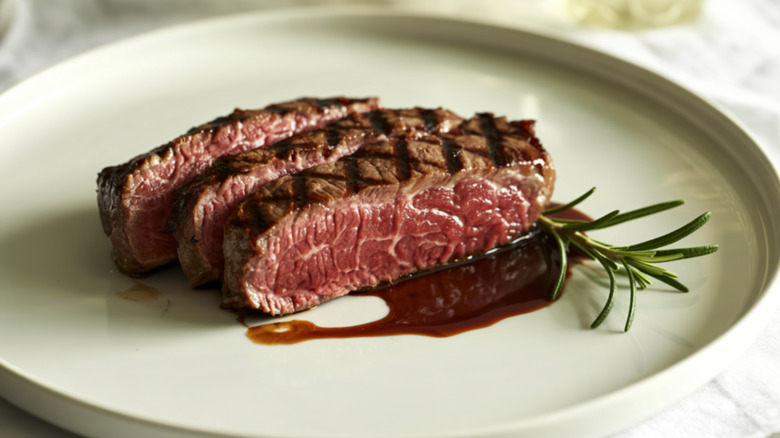The 4 Must-Know Terms For Ordering A Steak In France
If you're preparing for a highly anticipated French getaway, chances are you've been brushing up on vocabulary terms to make the vacation smooth and enjoyable. Still, no amount of crash-course language learning can really prepare you for the intricacies of French cuisine, at least not without a little help. There are plenty of French foods you should have on your radar, but if you've got your heart set on a delicious steak dinner while visiting France, don't limit yourself to just knowing the French word for your favorite cut.
While it's helpful to know that entrecôte is a ribeye and both faux-filet and contre-filet can be used to refer to a strip steak (though the former is sometimes more closely associated with sirloin), you may reach a bigger stumbling block when your server asks how you would like your steak cooked: "Quelle cuisson, votre steak?" That's why the four most common French terms for steak doneness — bleu, saignant, à point, and bien cuit — are arguably the most important terms you need to know before ordering a cut in France.
Bleu
When it comes to ordering a steak in France, bleu (pronounced "ble" or "bluh") is the rarest option. The most commonly accepted theory explaining its nomenclature is the somewhat blue or purple tinge that's sometimes visible in raw steak. This carries over to the cooking method: Bleu steak has an outside that's quickly seared over very high heat, leaving the inside cool and almost entirely raw. Bleu steak is typically removed from the heat when it hits an internal temperature of 105-110 degrees Fahrenheit (or 40-43 degrees Celsius), but some chefs opt for as low as 90 degrees Fahrenheit (or 32 degrees Celsius).
While the USDA's Food Safety and Inspection Service lists the safe minimum internal temperature for steak at 145 degrees Fahrenheit, bleu steak is safe to eat under the right conditions. Those conditions include a reputable restaurant with high-quality beef and safe meat-handling practices. It's also important that the entire outside of the steak is seared, killing any harmful bacteria that may exist on the surface of the meat due to cross-contamination.
Saignant
If bleu is just a little too rare for your taste when ordering a steak in France, saignant (pronounced "say-nyon") may be a better option. You should know, however, that this is still rare by American standards. Saignant translates to "bleeding" in English, though the juices from a rare steak aren't actually blood — they're reddish-pink thanks to a protein called myoglobin. Still, "bleeding" certainly paints a picture of what you can expect.
Saignant steak in France is cooked slightly longer than bleu steak, reaching an internal temperature of around 125-130 degrees Fahrenheit (or 52-54 degrees Celsius). This will leave the inside cool to warm but still quite red, while the outside will have a harder sear. This preparation is a great way to dip your toe into the world of rare steak on your French vacation. You can experience what many consider to be a buttery tenderness without feeling like you're eating raw beef.
À point
If you often find that your steak comes out too well-done for your liking when you order it medium-rare in the U.S., but ordering a rare steak results in something a little too rare, try ordering your cut à point (pronounced "ah-pwa") while in France. This is sometimes seen as the equivalent of an American medium-rare steak (with an internal temperature of 130-140 degrees Fahrenheit, or 55-60 degrees Celsius), but others argue that it leans closer to rare.
The French, in general, like their meat cooked much less than Americans tend to prefer, and à point is all about French preference. This is because à point translates to "perfectly cooked" or "just right," and the range between rare and medium-rare tends to be the most common preparation for the average French diner, who generally opts for rarer meat. Expect your steak à point to be slightly warm on the inside but still red, juicy, and tender.
Bien cuit
If all this talk of rare steak has your stomach churning, your best bet when ordering a steak in France is to order it bien cuit (pronounced "bien-kwee"), which translates to "well-cooked" or "well-done." Like many of the other steak temperatures in France, however, bien cuit is less well-done than its American counterpart. It's still pink on the inside and closer to what Americans would call medium or medium-well.
If you really have your heart set on what Americans would consider a well-done steak, order your French steak très bien cuit, or "very well-cooked." While this doesn't actually translate to a particular temperature in French kitchens, the chefs of which balk at the very idea of cooking meat well-done, your waiter and chef will understand what you mean, much to their chagrin. In fact, if you prefer your meat well-done, France may not be the best place for you to order steak in the first place, though Ina Garten has said great things about the country's sandwiches.




